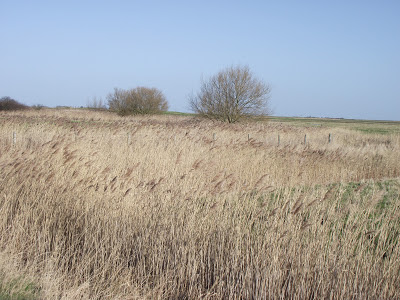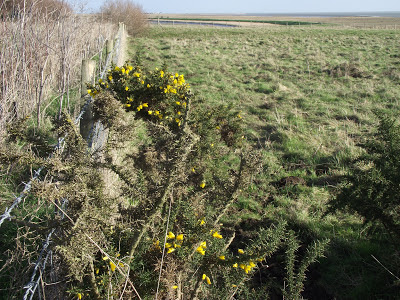Monday, 4 February 2013
Sunshine at Last
Its was a real pleasure both Saturday morning and today to walk round the reserve not only under clear blue skies but with the sun so increasing in strength so that it was warm on the back of my jacket and head. The photo above was taken by my girlfriend Di Gardner from the new Tower Hide on Saturday and shows the sun being reflected off the flooding in the aptly named Flood Field.
This morning, if it wasn't for a strong and cold NW wind it could of been almost Spring-like and indeed was in sheltered spots out of the wind. Mind you, the benefit of the drying wind and sun combination, which is forecast to last all week, is that the ground surface will quickly dry out and make walking round so much more pleasant, what a joy that will be!
The photos above and below show the reserve this morning under the blue skies and sunshine and looking a lot dryer than it actually was. It seems silently waiting for the Spring that is hopefully just a few weeks away, like the first Lapwing's nest and the first Wheatear along the boundary fence. It's the time that we we wish our life away wishing that we could simply jump over the drag of February and be straight into March.
The reed beds and the willows wait patiently as well, soon to be turning green and welcoming back Reed and Sedge Warblers, all the way from Africa to nest again. The Greylag Geese also seem to sense something and have begun pairing up and squabbling is taking place in the flocks as males chase away other interested males from their chosen mates.
Perhaps I'm getting ahead of myself and for sure there will be more cold weather yet to spoil the mood but even the reserve's only two gorse bushes had flowered for the party today.
On Friday the inland shooting season finished for another season and by all accounts has been pretty poor, with, as I have mentioned before, wild ducks being very much at a premium and a cause for some concern locally, especially Mallard. Perhaps that's the reason why the last-day shoot across a marsh in N. Kent last Thursday saw fit to shoot and kill 50+ Coots, for no other reason than it is legal to do so and they provided extra targets. To justify this, luckily, uncommon form of shooting these days, those doing it will cite the fact that the birds eat corn put round ponds to attract in wildfowl for shooting. While I have been openly supportive of some forms of shooting in recent years, this form takes shooting down to despicable levels and leaves those doing it deserving of the condemnation that they get. Once again it highlights the gung-ho and large bag nature of the inland commercial shoots - such a different outlook to that of the lone and discreet wildfowler along the shoreline.
I have brought the subject of shooting both Coot and Moorhen up before and still find it hard to accept why, in this day and age, conservation groups still find it acceptable for those two birds to remain on the legal shooting lists and haven't lobbied for their removal. Lets face it, I doubt that many of those that have shot those birds have thought seriously about trying to eat them, they hardly look a tasty treat.
That aside, it just leaves wildfowling still able to take place below the high water mark on the seaward side of the seawall until the night of February 20th. Yesterday morning at first light I stopped to have a customary chat to three wildfowlers as they came back to the sea wall from off the saltings in front of the reserve. They had sat out in the mud for almost three hours, were frozen stiff and between them had shot just one Teal, something that exemplifies the huge difference between wildfowling and the type of shooting described above. OK, it was still one Teal too many if you are one of the "ban all forms of hunting" types that regularly hug each other on this topic in local blogs these days, but me, I see it as proof that wildfowling in most cases, is easily the hardest and least productive form of shooting in the countryside.
Subscribe to:
Post Comments (Atom)





Hi derek, I like reading your blog. I'm a wildfowler and have seen you in passing once or twice on the Island.
ReplyDeleteIf the North Kent marsh that shot the coots is the one I'm thinking of, then I think it only right that I point out that those coots were shot to reduce the numbers on the marsh before the wildfowl breeding season starts. They do it every year towards the end of the season to reduce the numbers of nesting coots on the marsh. I'm sure you are aware that coots are very territorial and aggressive towards any other birds during the breeding season. Too many of them on any given waterway disrupts the breeding success of many other species of wildfowl.
And yes, the bias is usually in favour of duck and goose breeding success over anything else on that marsh! But the reduction in coot numbers benefits many species.
You may disagree though.
Thanks for your comment Prince, I was aware that that was/is the official reason for the shooting of the coots, although a friend that was there said that those shooting the birds spoke more in terms of simply shooting them for fun because they were easy targets. There is also no guarantee that all the coots present were resident birds, many may of been winter visitors. It is also my life-time experience of waterbirds that coots nest in open waterways whilst most other wildfowl nest close by but not in the waterway. This means that while coots can be aggresive to other birds, it only occurs on the odd occasion that a brood of ducks passes a coot breeding pair.
ReplyDeletePersonally I think your given reason for shooting the birds is the use of an old and out-dated practise in order to excuse easy shooting by a number of trigger happy shooters that do their sport a dis-service. Mute Swans have been known to adopt similar aggresive reactions at times, were they on the shooting list would we see a similar shooting spree against these birds, using the same excuses.